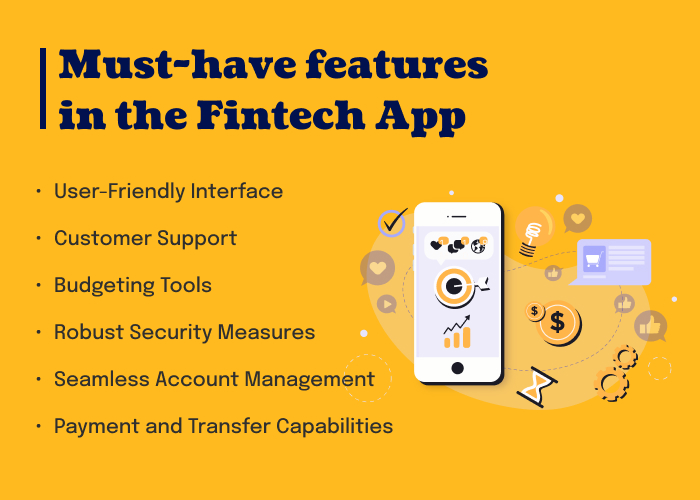Must-have features in the fintech app

Here are the must-have features for any fintech application aiming to succeed in today’s competitive market:
- User-Friendly Interface: An easy-to-navigate interface ensures users can access and use features without confusion. Furthermore, customizable dashboards and personalized experiences enhance engagement and satisfaction.
- Robust Security Measures: Add an extra layer of security to protect user accounts from unauthorized access. Furthermore, ensure all sensitive information is encrypted both in transit and at rest to prevent data breaches.
- Seamless Account Management: Allow users to manage multiple bank accounts, credit cards, and investment accounts in one place. Moreover, informs users of instant alerts on transactions, account balances, and suspicious activities.
- Payment and Transfer Capabilities: This feature lets users send and receive money instantly to/from friends and family. Facilitate the payment of utility bills, loans, and other recurring expenses directly from the app.
- Budgeting Tools: Automatically categorizing and tracking spending helps users to manage their budgets effectively. Allow users to set and track progress toward savings and investment goals.
- Customer Support: There is no doubt that customer support plays an important role in the success of any app. Thus, providing instant support through live chat or AI-driven chatbots is a must to add to a fintech app.
Factors that affect the cost of developing fintech app
Now you have understood the features to add to the fintech application, below is a detailed explanation of which factors affect the cost of development:
App Complexity
The price increases with the number of features and functionalities you choose. For instance, complex features are user identification, budgeting tools, payment processing, and investment tracking. More effort and money are needed to create a more complex, user-friendly design.
Development Team
Because of pay and benefits, hiring staff internally may be more expensive than outsourcing, which might provide more affordable options. The quantity and caliber of developers, designers, testers, and project managers engaged have a big impact on the total cost. For example, hiring a fintech app development agency from India will cost you less compared to the USA.
Technology Stack
The choice of programming languages, frameworks, and databases impacts the cost. Furthermore, integrating third-party services for payments, analytics, or customer support can add to the cost.
Geographic location
Development costs vary significantly by region. For instance, developers in North America or Western Europe tend to charge more than those in Asia.
Project Timeline
Because of the necessity for speedier work and additional developers, shorter development timelines sometimes result in increased expenses and resource requirements.
Testing and Quality Assurance
The cost of development goes up when a product undergoes extensive testing to make sure it is error-free and functions properly in many scenarios. Thus, involving actual users in the testing process might aid in problem identification, but it also necessitates more resources.
Maintenance and Support
It is necessary to account for ongoing costs such as customer support, bug repairs, upgrades, and post-launch maintenance. Additionally, significant upfront expenditure is needed to prepare for future expansion and make sure the app can scale with a rising user base.
Thus, considering a number of variables, such as the functionality, technology stack, UI/UX design, development team, location of the team, etc., a fintech app costs between $45,000 and $200,000 or more.
Conclusion
Fintech app development is an expensive endeavor that depends on a number of variables, including the app’s complexity, the development team, the technological stack, the location, and continuing upkeep.
You may more effectively control expenses and make wise selections during the development process if you comprehend these components. The way people handle their money may be completely changed by a well-thought-out fintech software that provides unmatched efficiency, security, and ease.
FAQs
How long does it typically take to develop a fintech app?
What are the key security measures to consider in fintech application development?
Can I integrate third-party services into my fintech application?
How do I ensure my fintech application complies with financial regulations?
Ensuring compliance involves understanding and adhering to relevant regulations such as KYC (Know Your Customer), AML (Anti-Money Laundering), GDPR (General Data Protection Regulation), and PCI DSS (Payment Card Industry Data Security Standard). Working with legal experts and incorporating compliance checks during development can help meet these requirements.
What strategies can help boost the conversion rate of my fintech application?
Ravi Bhojani is the Chief Marketing Officer (CMO) at Alian Software, where he spearheads the company’s marketing strategies and drives its brand presence in the competitive IT services landscape. With over a decade of experience in the technology and marketing sectors, Ravi has consistently demonstrated his ability to blend innovative marketing techniques with deep industry knowledge to deliver outstanding results.